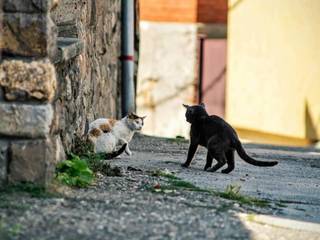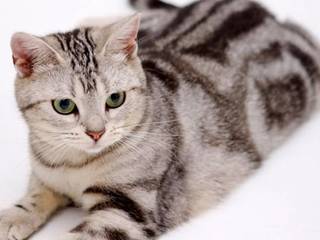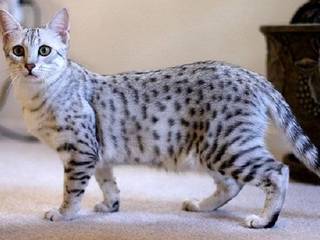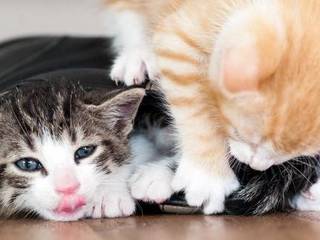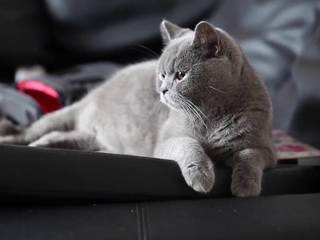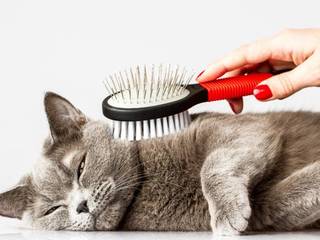Cats have been popular pets for thousands of years, and it's not hard to see why. With their cute faces, playful personalities, and independent nature, it's no wonder that so many people are crazy about these furry felines. If you are looking to learn some interesting cat facts, you are in the right place!
Whether you're a seasoned cat owner or simply a fan of these fascinating creatures, there's always something new to learn about them. In this article, we've gathered 20 fun cat facts that are sure to delight any cat lover.
1. The Egyptian Mau is likely one of the oldest breeds of cats.
The Egyptian Mau is a breed of domestic cat that originated in Egypt. The name "Mau" is an Egyptian word for "cat," and these cats have been highly valued in their homeland for thousands of years.
The Egyptian Mau is a medium-sized cat with a muscular build and a distinctive spotted coat. The spots can be black, brown, silver, or smoke-colored and are randomly distributed over the cat's body. The coat is short and silky, and the Mau has a long, tapering tail and almond-shaped green eyes.
Egyptian Maus are known for their intelligence and athleticism. They are active and agile and enjoy climbing, jumping, and exploring. They are also known for their loyalty and affection towards their owners and are often described as being "dog-like" in their behavior.
One unique feature of the Egyptian Mau is their "gooseberry green" eyes. This is a shade of green that is unique to the breed and is highly prized by Mau enthusiasts.2. Just like humans, cats can be left-handed or right- handed or, rather, have a dominant paw!
And data overwhelmingly shows that males tend to be left-pawed while females tend to be right-handed, or pawed. In a study performed in 2009 at the University of Belfast, researchers found that the concept of paw preference in cats is similar to the idea of handedness in humans, but it is not as well understood.
Researchers at the university conducted various studies to investigate whether cats have a preference for using one paw over the other and, if so, whether this preference is consistent across different tasks.
With less complicated tasks like hitting or swatting at a toy, both male and female cats seemed to use their right and left paws interchangeably.
For more complex tasks where more dexterity may be needed, male cats used their left paws significantly more to try to scoop tuna out of a jar. Only one male cat out of the 21 tested varied in that he was ambidextrous and utilized both paws to scoop out the tuna. On the other hand, 20 of the 21 females almost always used their right paw for the task.
3. Cats have a detached collarbone.
To help support their spine and enable their nimble movements, cats have evolved a collarbone that is not connected to the rest of their skeleton. This "floating collarbone," also known as the wishbone or furcula, is a small, V-shaped bone that sits at the base of the cat's neck, near the shoulders.
Additionally, cats have a highly flexible and adaptable spine, which allows them to move in ways that seem almost impossible for other animals.
This incredible range of motion makes cats excellent climbers and hunters, as they can quickly navigate complex environments and catch prey with ease.
4. Cats have three eyelids
Cats, like many other animals, have an extra eyelid called the "nictitating membrane" or "third eyelid." This membrane is a thin, translucent layer of tissue that covers the cat's eye from the inside corner to the outside corner.
The third eyelid is not normally visible when a cat is awake and alert, as it retracts into a pocket located in the lower inner corner of the eye. However, you may notice it when your cat is asleep or relaxed, as it may appear as a thin, white, or pink membrane covering part of the eye.
The third eyelid serves several purposes. First and foremost, it provides an additional layer of protection for the cat's eye, shielding it from injury or damage. The third eyelid also helps to keep the eye moist and lubricated by spreading tears across the surface of the eye. Additionally, the third eyelid contains lymphoid tissue, which is part of the cat's immune system and helps to fight off infections.
In some cases, the third eyelid may become more visible than usual, indicating a potential health problem. This can happen if the cat is sick or has an eye injury or if there is an underlying condition affecting the third eyelid itself.
If you notice that your cat's third eyelid is unusually prominent or covering more of the eye than usual, it's a good idea to have them evaluated by a veterinarian.
5. Cats can sweat through their paws.
Cats do not have sweat glands distributed throughout their body as humans do. Instead, they have sweat glands only in certain areas, such as their paw pads. These sweat glands, called eccrine glands, are responsible for helping cats regulate their body temperature and maintain hydration levels.
When a cat is hot or stressed, the sweat glands in its paw pads will release moisture to help cool them down. This moisture can often be seen as wet paw prints left behind by a cat as they walk across a surface.
It's worth noting, however, that sweating through their paw pads is not the primary way cats regulate their body temperature. Cats primarily regulate their body temperature through panting and grooming, which helps to cool their bodies down by promoting the evaporation of moisture from their fur.
6. Cats only meow to communicate with humans.
Meowing is a vocalization behavior that domestic cats have developed to communicate with humans. Unlike wild cats, domestic cats meow to interact with humans, not with other cats. In the wild, adult cats mainly communicate with each other using body language, scent marking, and vocalizations such as growling, hissing, or yowling.
However, domestic cats have adapted their communication style to better interact with humans, who are their primary caregivers. They have learned that meowing can get the attention of humans and communicate their needs or desires. By meowing, a cat can signal that it wants food, water, attention, or access to a certain area.
Studies suggest that cats can alter the tone and pitch of their meows depending on what they want from their human companions. For example, a high-pitched meow is often used to communicate hunger or to solicit attention, while a low-pitched meow is used when cats are feeling unhappy or angry.
Interestingly, kittens are the only cats that meow at each other, and they stop doing so as they grow up and learn to communicate with body language and other vocalizations. This further supports the idea that meowing is a behavior that domestic cats have developed specifically to interact with humans.
7. A cat’s purr typically vibrates at a frequency between 25 and 150 Hertz.
A cat's purr is a low, rumbling sound that cats make when they're content, relaxed, and happy. It's a sound that's often associated with relaxation and comfort, and it's something that many people find soothing and calming.
The sound of a cat's purr is created by the vibration of the cat's vocal cords, which are located in the larynx or voice box. When a cat purrs, the muscles in its larynx rapidly contract and relax, causing the vocal cords to vibrate at a frequency between 25 and 150 Hertz. This vibration produces the characteristic rumbling sound of a cat's purr.
While a cat's purr is often associated with contentment and relaxation, cats may also purr when they're feeling stressed, anxious, or in pain. Some research suggests that the act of purring may have therapeutic benefits for cats, including reducing stress and promoting healing.
Additionally, some studies have shown that the sound of a cat's purr may have a calming effect on humans, helping to reduce stress and promote feelings of well-being.
8. Cats have contributed to the extinction of many species.
Cats, both domestic and feral, have been known to hunt and kill a variety of wildlife species, and in some cases, their hunting activities have contributed to the extinction or decline of certain species.
One example of this is the Stephens Island Wren, a flightless bird that was endemic to Stephens Island off the coast of New Zealand. In the late 1800s, the island was home to a lighthouse, and a cat named Tibbles was brought to the island to control the rat population. However, Tibbles ended up preying on the wrens, and within a few years, the species was extinct.
Another example is the Hawaiian bird species that have been impacted by feral cats. Cats were introduced to Hawaii by European settlers in the 1700s, and since then, they have preyed on many bird species, including the Hawaiian Goose, Hawaiian Petrel, and Hawaiian Crow. Some of these bird species are now critically endangered, and cats are considered one of the major factors contributing to their decline.
While cats have undoubtedly had a negative impact on certain species, it's important to note that they are not the only factor contributing to extinction. Habitat loss, climate change, and other human activities are also major factors that have impacted wildlife populations around the world.
9. Cats can suffer from acne.
Cats can suffer from a condition called feline acne, which is similar to human acne. Feline acne is a common skin condition in cats, particularly in those with oily skin. It typically appears as blackheads, pimples, or pustules on the chin, lips, and around the mouth area.
The exact cause of feline acne is not known, but it is believed to be a result of the overproduction of sebum, a natural oil produced by the skin. This can lead to clogged hair follicles, which can then become infected with bacteria, causing acne to develop.
Feline acne can be a chronic condition that can recur throughout a cat's life. It is more common in cats with poor grooming habits, those with plastic food dishes, and those with weakened immune systems. Stress and hormonal imbalances can also contribute to the development of feline acne.
If left untreated, feline acne can become painful and lead to secondary infections. Treatment options for feline acne include cleaning the affected area with a mild antiseptic, using topical or oral antibiotics to treat bacterial infections, and in severe cases, corticosteroids may be prescribed to reduce inflammation.
10. Cats can hear three times better than humans.
A cat's hearing is extremely good and is one of its most developed senses. They have a remarkable ability to hear high-pitched sounds and can hear sounds at frequencies up to 65,000 hertz, while humans can only hear up to 20,000 hertz.
Cats are also able to locate the source of a sound with great precision. Their ears are mobile and can rotate up to 180 degrees, which helps them to detect the direction of a sound. They also have a complex inner ear that allows them to maintain their balance and orientation, which is important for hunting and other activities.
11. A cat’s sense of smell is 14 times better than humans’ sense of smell.
Cats have a highly developed sense of smell, which plays an important role in their daily lives. In fact, cats have over 200 million odor receptors.
Cats have a specialized organ in their noses called the Jacobson's organ, or vomeronasal organ, which allows them to detect pheromones and other scents that are not detectable by humans. This organ is located on the roof of the mouth and is connected to the nasal cavity.
Cats use their sense of smell to navigate their environment, identify prey, and communicate with other cats. For example, they can use their sense of smell to track a mouse, locate a hidden toy, or find their way back to their home.
Cats also use their sense of smell to communicate with other cats. They can detect the pheromones in another cat's urine and use this information to determine if the cat is male or female, if it is in heat, and if it is familiar or a stranger.
12. Cats' whiskers help them navigate.
Cats' whiskers, also known as vibrissae, are specialized sensory hairs that grow on a cat's face, above their eyes, on their cheeks, and around their mouth. These hairs are thicker and stiffer than normal fur, and they are deeply rooted in the cat's skin.
Cats use their whiskers for many purposes, including navigation, hunting, and communication. Whiskers are highly sensitive and can detect even the slightest changes in their environment, including changes in air currents, temperature, and texture. This helps cats navigate in the dark, sense prey, and avoid obstacles.
Whiskers also play a role in a cat's social communication. For example, when a cat is feeling threatened or is aggressive, it may flare its whiskers to make itself appear larger and more intimidating.
Cats also use their whiskers to express emotion, such as when they are happy or relaxed, their whiskers may be positioned in a more neutral or forward-facing position.
13. Cats have scent glands in their cheeks and chin.
Cats have scent glands located on their cheeks, also known as the "cheek pads" or "whisker pads." These glands are called the "zygomatic glands," and they secrete pheromones, which are chemical substances that are used for communication between cats.
When cats rub their cheeks against objects, people, or other animals, they are depositing these pheromones as a way to communicate their presence and mark their territory. This behavior is known as "bunting," and it's a way for cats to establish social bonds with each other and communicate non-verbally.
The pheromones released from the cheek glands also play a role in calming and comforting cats. When cats feel stressed or anxious, they may rub their cheeks against objects as a way to release pheromones that can help to reduce their stress levels.
There are also synthetic versions of these pheromones available in products such as Feliway, which are designed to help cats feel more calm and comfortable in their environment. By mimicking the natural pheromones released from the cheek glands, these products can help to reduce anxiety and unwanted behavior in cats.
14. Cats may help improve humans’ cardiovascular health.
There is some evidence to suggest that cats may have a positive impact on human cardiovascular health. Studies have shown that petting a cat can lower blood pressure and reduce stress levels, which can be beneficial for people with hypertension or other cardiovascular conditions. Additionally, owning a cat has been associated with a lower risk of heart attack and stroke.
One theory for why cats may have these benefits is that their purring produces a low-frequency vibration that can have a calming effect on the body. This may help to lower stress levels and promote relaxation, which can, in turn, have positive effects on cardiovascular health.
15. Even house cats can be fast.
On average, a domestic house cat can run at speeds of up to 30 miles per hour for short distances. However, the actual speed of a house cat can vary depending on various factors such as age, breed, weight, and physical condition.
Some breeds, such as the Siamese or Abyssinian, are known for being particularly fast and agile. However, it's worth noting that domestic cats are typically more suited for short bursts of speed and are not capable of maintaining high speeds over long distances like their wild counterparts.
16. It was illegal to injure or kill cats in ancient Egypt.
In ancient Egypt, cats were highly revered and considered sacred animals. They were associated with the goddess Bastet, who was the goddess of fertility, love, and protection. As a result, killing a cat in ancient Egypt was considered a serious crime, punishable by death.
There were several reasons why cats were so highly regarded in ancient Egypt. One reason was that cats were believed to have the ability to protect people from harm. They were also believed to have healing powers and were often used in medicine. In addition, cats were seen as symbols of grace and elegance and were often depicted in art and literature.
The ancient Egyptians believed that cats had a special connection to the divine and that harming a cat could bring about the wrath of the gods. They also believed that cats had the power to ward off evil spirits and protect their homes from harm.
Because of their sacred status, cats were often mummified and buried with great honor. Many tombs and temples contained depictions of cats, and many people owned pet cats that were treated like members of the family.
17. Cats’ noses have their own unique nose print.
A cat's nose print is a unique identifier, much like a human fingerprint. Each cat has a distinctive pattern of bumps and ridges on their nose pad that is as individual as their DNA.
The nose print of a cat is made up of a series of ridges, known as dermal ridges, which create a unique pattern. These ridges serve a similar purpose to the ones found on human fingertips - they help improve traction and provide a better grip on surfaces.
Just like a human fingerprint, a cat's nose print can be used to identify them. In fact, some animal shelters and rescue organizations have started using nose print scanning technology to track lost or missing cats and reunite them with their owners.
18. Black cats are symbols of good luck in some countries and bad luck in others.
Black cats are considered a sign of good luck in many cultures around the world. In some European countries, for example, it is believed that if a black cat crosses your path, it will bring good luck and prosperity.
In Scottish folklore, a strange black cat's arrival at your home is believed to indicate future wealth. Additionally, in Japan, the "Maneki-neko," or "beckoning cat," can be found in black, white, or other colors and is believed to bring good luck and prosperity regardless of its color.
While there are some cultural beliefs that associate black cats with bad luck, such as in some parts of the United States, the predominant view is that they are a positive omen.
19. Adult cats are lactose intolerant.
Adult cats are generally lactose intolerant, which means they lack the necessary enzymes to break down lactose, a sugar found in milk and other dairy products. When cats consume lactose, it can lead to digestive upset such as diarrhea, vomiting, and abdominal pain.
While it may be tempting to offer your cat a bowl of milk or other dairy products, it's best to stick to their regular diet of high-quality cat food and fresh water. If you do want to offer your cat a treat, there are many lactose-free cat foods and treats available on the market.
20. A group of cats is sometimes called a “Clowder.”
The word "clowder" is an old English term that originally referred to a ball of string or yarn. Over time, the word also came to be used to describe a group of cats. It's believed that this term came into use because cats are known to play with balls of yarn, and the word "clowder" was already in use to describe such a ball.
The use of the word "clowder" to describe a group of cats has been documented in English since the 14th century, and it is still in use today, although other terms such as "clutter" or "glaring" are also used to describe a group of cats.

